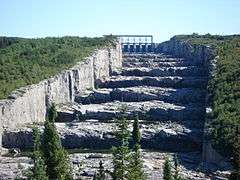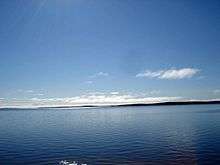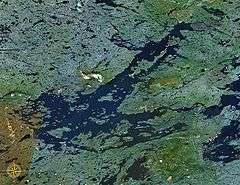Robert-Bourassa generating station
| Robert-Bourassa Generating Station | |
|---|---|
 | |
| Official name | Centrale Robert-Bourassa |
| Location | Baie-James, Quebec, Canada |
| Coordinates | 53°47′43″N 77°26′26″W / 53.79528°N 77.44056°WCoordinates: 53°47′43″N 77°26′26″W / 53.79528°N 77.44056°W |
| Construction began | 1974 |
| Opening date | 1981 |
| Construction cost | C$3.8 billion (1987) |
| Owner(s) | Hydro-Québec |
| Dam and spillways | |
| Type of dam | Embankment dam |
| Impounds | La Grande River |
| Height | 162 m (531 ft) |
| Length | 2,835 m (9,301 ft) |
| Width (crest) | 9 m (30 ft) |
| Spillway capacity | 17,600 m3/s (621,538 cu ft/s) |
| Reservoir | |
| Creates | Robert-Bourassa Reservoir |
| Total capacity | 61.7 km3 (50,000,000 acre·ft) |
| Surface area | 2,835 km2 (1,095 sq mi) |
| Power station | |
| Hydraulic head | 137.2 m (450 ft) |
| Turbines |
16 × 351 MW Francis turbines |
| Installed capacity | 5,616 MW |
|
Sources: * Société d'énergie de la Baie James 1987, pp. 117–180; 370*Hydro-Québec, The La Grande Complex visitor booklet, 2004, ISBN 2-550-41276-1 | |
The Robert-Bourassa generating station (formerly known as La Grande-2) is a hydroelectric power station on the La Grande River that is part of Hydro-Québec's James Bay Project in Canada. The station can generate 5,616 MW and its 16 units were gradually commissioned between 1979 and 1981.[1] Annual generation is in the vicinity of 26500 GWh.[2]
Together with the adjacent 2,106 MW La Grande-2-A generating station (LG-2-A), commissioned in 1991-1992, it uses the reservoir and dam system of the Robert-Bourassa Reservoir to generate electricity. The two plants taken together account for more than 20% of Hydro-Québec's total installed capacity of 36,810 MW in 2009.[1] It is Canada's largest hydroelectric power station and currently ranks in 8th place on the list of largest hydroelectric power stations.
Initially known as La Grande-2, it was renamed after Robert Bourassa who, as Premier of Quebec (1970–1976 and 1985–1994) gave the James Bay Project a vital political impetus.
Context
The Robert-Bourassa generating station is the main facility of the James Bay hydroelectric project, a large hydroelectric complex built on the La Grande River, a large river in Quebec's scarcely populated northern Quebec. It was also the first to be built, between 1974 and 1981. It was inaugurated by Premier René Lévesque of Quebec, on October 27, 1979.
Conception work on the generating station, dam and reservoir began in October 1970 when Montreal-based engineering firm Rousseau Sauvé Warren (RSW) was given by Hydro-Québec to make the case for the development of the La Grande River. Another engineering firm, Asselin, Benoît, Boucher, Ducharme & Lapointe (ABBDL) was tasked with a feasibility study on the more southerly NBR (Nottaway, Broadback, Rupert) concept. At RSW the development of the La Grande River was championed by François Rousseau, one of firm's associates and a former Hydro-Québec senior engineer.[3]
A final decision to build the hydroelectric complex on the La Grande hydrographic system was made in 1972, after engineers determined the NBR project would be less cost effective because of the silty nature of the soils in the NBR area. The La Grande option had the added advantages of a lesser impact on First Nations hunting and fishing, on the boreal forest and would require less flooding.[4]
Construction
The main dam is located 117.5 kilometers (73.0 mi) from the mouth of the river, in the transition zone between the plateau and the coastal plain, and has a maximum height of 162 meters (531 ft). Twenty-nine dykes of various sizes close the reservoir. They are organized in three group: dykes D1-D4 are located north of the spillway, nicknamed the Staircase of the Giants,[5] D5-D14 are located on the left shore of the river while a third group, nicknamed the Duncan dykes (D17-D27), are located 30 kilometers (19 mi) south. The dam and dykes hold a reservoir covering an area of 2,835 square kilometres (1,095 sq mi) with a useful capacity of 19.365 billion m³.[6]
The generating station itself is located underground, 6 kilometers (3.7 mi) downstream from the main dam. It hosts 16 Francis turbines, set up in two groups of eight each.[6]
In 1974, in what was one of the most extreme cases of workplace sabotage up to that time, workers at the La Grande-2 site used bulldozers to topple electric generators, damaged fuel tanks, and set buildings on fire. The project was delayed a year, and the direct cost of the damage estimated at $2 million CAD. The causes were not clear, however three factors have been cited: inter-union rivalry, poor working conditions, and the perceived arrogance of American executives at the contractor, Bechtel Corporation.[7]
Road

The first step towards the construction of the La Grande-2 generating station took place in June 1971, in Matagami, a small mining town located 630 kilometers (390 mi) south of La Grande River. Engineering firm Desjardins, Sauriol and Associates were tasked with the construction of a basic road to the future site and the Cree settlement at Fort George. The deadline was tight: 450 miles (720 km) in 450 days.[9]
The first challenge involved deploying teams of land surveyors and lumberjacks by seaplanes and helicopters to clear a path for a permanent road. Parallel to the path, a few kilometres away, an ice road was built to move heavy machinery north. The first milestone was reached on February 11, 1972, with the opening of the 555 meters (1,821 ft)[10] ice bridge crossing the Rupert River.[11]
La Grande-2-A
Photos
-

Main entrance of the underground generating station.
-

The spillway, nicknamed The Staircase of the Giants, and dam (partially visible).
-

The spillway, nicknamed The Staircase of the Giants.
-

The Robert-Bourassa Reservoir, near the generating station.
-

The Robert-Bourassa Reservoir, as seen from space.
-

Electric transformers at the plant's switchyard.
See also
- List of conventional hydroelectric power stations
- List of hydroelectric stations in Quebec
- Reservoirs and dams in Canada
References
- 1 2 Hydro-Québec Production (2010), Hydroelectric Generating Stations (as of December 31, 2009), Hydro-Québec, retrieved 2010-08-21
- ↑ Pierre Parent of Hydro-Quebec (2004), Implementing Detailed Efficiency Data for Optimal Use in Hydroelectric Generating Plants (PDF)
- ↑ Bolduc 2000, pp. 114–115
- ↑ Bolduc, Hogue & Larouche 1989, p. 263
- ↑ Turgeon 1992, p. 111
- 1 2 Société d'énergie de la Baie James 1987, p. 117
- ↑ Rinehart, J.W. The Tyranny of Work, Canadian Social Problems Series. Academic Press Canada (1975), pp. 78-79. ISBN 0-7747-3029-3. See also Auf Der Maur, in Further Reading.
- ↑ Société d'énergie de la Baie James 1987, p. 54
- ↑ Lacasse 1983, pp. 242–246
- ↑ Société d'énergie de la Baie James 1987, p. 58
- ↑ Lacasse 1983, pp. 257
Works cited
- Bolduc, André; Hogue, Clarence; Larouche, Daniel (1989), Hydro-Québec, l'hértitage d'un siècle d'électricité (in French) (third ed.), Montreal: Libre-Expression / Forces, ISBN 2-89111-388-8 (also available in English, under the title Hydro-Québec After 100 Years of Electricity)
- Bolduc, André (2000), Du génie au pouvoir : Robert A. Boyd, à la gouverne d'Hydro-Québec aux années glorieuses (in French), Montreal: Libre Expression, ISBN 2-89111-829-4.
- Lacasse, Roger (1983), Baie James, une épopée, Montreal: Libre Expression, ISBN 2-89111-109-5.
- Société d'énergie de la Baie James (1987), Complexe hydroélectrique de la Grande-Rivière. Réalisation de la première phase (in French), Montreal: Société d'énergie de la Baie James/Éditions de la Chenelière, ISBN 2-89310-010-4.
- Turgeon, Pierre (1992), La Radissonie, le pays de la baie James (in French), Montreal: Libre expression, ISBN 2-89111-502-3.
External links
| Wikimedia Commons has media related to Aménagement Robert-Bourassa. |
| ||||||